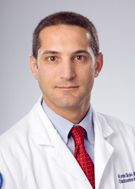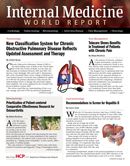The Increased Incidence, Risk Factors, and Prevention of Clostridium Difficile: A Q&A with Kevin Skole
Kevin Skole, MD is a board-certified gastroenterologist practicing in central New Jersey, part of the gastroenterology division of Princeton Healthcare Affiliated Physicians, a multi-specialty medical practice based out of the University Medical Center of Princeton at Plainsboro (see www.princetonhcs.org). He discusses the increased incidence, risk factors, and prevention of Clostridium Difficile (C. diff) infection.
Internal Medicine World Report
Kevin Skole, MD is a board-certified gastroenterologist practicing in central New Jersey. He is part of the gastroenterology division of Princeton Healthcare Affiliated Physicians, a multi-specialty medical practice based out of the University Medical Center of Princeton at Plainsboro (see www.princetonhcs.org). He speaks withEditor-in-Chief, Simon Douglas Murray, MD, about the increased incidence, risk factors, and prevention of Clostridium Difficile (C. diff) infection.
What is Clostridium Difficile?
Clostridium Difficile, or

, is a gram negative bacterium that is ubiquitous in the environment including living in the large bowel of many humans. It generally is non-pathogenic, but may be active
when environmental factors cause a shift in normal balance of gut bacteria favoring its overgrowth. It causes a form of gastrointestinal illness, which can range from minor diarrhea to life threatening colitis. Formally it is called pseudomembranous colitis because of typical appearance on sigmoidoscopy. Illness associated with
is termed
associated diarrhea, with more severe cares labelled
colitis — there are about a half million cases reported each year.
C. diffC. diffC. diffC. diff
Dr. Skole, has the incidence of C. diff increased over the past several years?
The incidence of these infections has risen dramatically, particularly in the outpatient setting. The causes for the increased incidence are in large part antibiotic use. The widespread use of proton pump inhibitors may be contributing, but that’s not known for sure. Other factors may be the altered immune systems of an aging population, and changes to our bowel flora as a consequence of antibiotics in our food supply, or modern, more processed diets in general. New strains of the organism have emerged that produce more toxins than the previous strains and can infect those not in the hospital or taking antibiotics. The organism itself has developed into a more virulent and hardy pathogen making it more resistant to eradication. So it’s a combination of possible factors.
Is the infection fairly easy to transmit from patient to patient, since it can exist outside of the body for months at a time?
Yes. I have read that the organism can live outside of the body for as long as five months since it is shed in the form of spores, which can survive under very hostile conditions. Because it has been recently recognized that this is not a benign infection, and since we have become more knowledgeable about the natural history, we have begun to take it more seriously. Patients in the hospital afflicted with the infection are isolated and health care workers handle them with gloves and gowns. Part of the problem in the past has been inadequate hand washing or using water alone without effective sporicidal agents to reduce the possibility of transmission. Bleach is required to get rid of the spores, but that wasn’t focused on until recently. Nosocomial spread is an important part of the problem, but an interesting study from the UK looked at the genetic makeup of
organisms obtained from hospital patients which would seem to indicate that most infections in hospitals were antibiotic associated and not from nosocomial spread, although those cases were still considerable. Most of the growth of
incidence has come from children and outpatients, many of whom have limited contact with the health care system
C. diff C. diff
Are there any antibiotics that are worse than others in causing infection?
Obviously clindamycin has long been implicated, but quinolones have clearly emerged as the biggest offender, since they have a widespread use. They are potent inhibitors of gram negative organisms, and have a greater chance of altering bowel flora allowing
to take hold. Cephalosporin and penicillins are next most likely to cause infections, whereas the macrolides and trimethoprim sulfa are least likely to result in infection though, of course, any antibiotic can cause it.
c. diff
How is C. diff diagnosed?
In a patient with diarrhea and recent antibiotic use or recent hospitalization, the clinical suspicion is high. The gold standard test is an anaerobic culture for the organism, but takes weeks to get results back, so we have been measuring levels of bacterial toxins in the stool. Standard tests for toxin A and B are very specific, meaning a positive result generally indicates an infection but may miss up to 30% of patients who have the disease. This is because the levels of toxin may not reach the threshold required to be considered positive. In most institutions we are now using PCR or nucleic acid based tests, which looks for the genes that produce toxin. A negative test virtually rules out infection, but there are some false positives in patients who are colonized with low levels of the bacteria but may not be sick from it. This presents quite a challenge to decide if the positive test is actually responsible of the patient’s illness, or is the presence of toxins coincidental and not causative.
In the past we would perform sigmoidoscopy and find pseudo membranes in the large bowel, which were diagnostic of
infection, but this is rarely required anymore since we have accurate measurement of par. Sigmoidoscopy may be used to document the severity of the infection. An exception is when the patients present late in the course of illness with toxic mega colon — there is no diarrhea and they are not producing stool. In this setting, sigmoidoscopy is very useful for diagnosis, because the presence of pseudo membranes confirms the diagnosis and documents the severity of illness.
C. diff
What are the treatment options?
Cholestyramine has been used in the past, but has fallen out of favor because it may reduce symptoms, but does nothing to eradicate the infection. It may bind toxins, but tends to prolong the illness. The recent joint statement of the American College of Gastroenterology and the Infectious Diseases Society states that this agent should not be used other than in patients with such severe intractable diarrhea that they are getting dehydrated.
For mild infections, Metronidazole is frequently used, although not FDA approved for this indication . Interestingly, the IV formulation may be as effective as the oral form, unlike Vancomycin which must be given orally to be effective. Vancomycin is one of 2 drugs officially indicated for
, the other one being Dificid (Fidaxomicin). For moderate infection, or for those who are immune compromised, Vancomycin is the drug of choice. Dificid has a lower rate of recurrence and may have a place in treating recurrent infections.
c. diff
Vancomycin pulvules or capsules may cost $2,300 for a standard course, with Dificid costing up to $2,800. Vancomycin prepared as a solution is considerably cheaper ($300 for a course) but must be compounded and the result may not be as predictable as using the tablets.
Rifaximin is another treatment option, but most clinicians would not use this as the primary agent. There is some data to suggest a role for this drug as a follow up to Vancomycin to reduce the risk of recurrence.
Fecal transplants are a great success in the treatment of
. It is not a new therapy — fecal enemas were described as early as the 1950s. The efficacy of treatment in the literature is reported to be 80 to 100%; a report last week cited 100% success. In our hospital, 14 of 15 fecal transplant recipients were successfully treated.
C. diff
The process is rather straight forward, but the pre-transplant portion is the most difficult. A donor must be identified to provide stools. They are first screened with blood tests for HIV, hepatitis A, B, C, and for syphilis. The stool is tested for ova and parasites, giardia, as well as standard cultures for pathogens including listeria, campylobacter, isoporia, microsporidium, and cyclosporia. We obviously check for toxins to
. All in all, the cost of testing is between $500 and $800, for which the patient or insurance pays, though insurance companies are increasingly taking care of the costs. It is critical that the samples be prescreened to prevent any transmission of infections; in 2013 the FDA prohibited stool transplants until it was certain that proper screening of donors was standard practice.
C. diff
The donor must take a laxative on the day of the procedure then collect the stool and strain and mix it to a liquid consistency. The sample is refrigerated until brought to the hospital and inserted into the patient by a nasogastric tube or more commonly by colonoscopy. A doctor in Canada reported successful outcomes on 33 patients he had treated who received the transplant orally in capsule form.
It is possible to purchase stool samples prepared from a known screened patient pool. For instance, a Boston company will send a standardized stool solution overnight which is frozen but ready for use once defrosted. It costs about $250 per sample plus overnight shipping.
As a pre-prepared specimen saves the expense and discomfort of testing, and eliminates the need to prepare stool for donation, it is quickly gaining popularity. We are very excited about this option. It is cost effective, safe, and easy for patients and their families. It is easy for nurses and staff to defrost and administer via colonoscopy, as well.
Probiotics have a role in preventing relapse and in preventing antibiotic associated diarrhea. Their use in preventing primary
infections is controversial but there is little or no downside to treatment. A 2013 Cochrane review was favorable, and indicated the target number of patients needed to be treated was 26. We know for a fact that probiotics are effective at preventing antibiotic associated diarrhea especially in children, and pose no risk to anyone except perhaps immunocompromised patients where the risk is theoretical.
C. diff
Can you comment on the extensive studies about gut flora and its role in diseases?
Every month there is a new article in our literature about the role of gut flora in causing or preventing diseases like obesity, diabetes, autism, IBS, and inflammatory bowel disease This is a valid and emerging field of research, but as we speak, the entire spectrum of gut flora hasn’t been fully elaborated,. It is obviously an exciting, but, as of yet, unproven future treatment avenue.
What is on the horizon in terms of testing and treatment?
Vaccines are being developed to prevent infection. Better screening tests will tell us who is predisposed to
infections and will alert us against antibiotic overuse. New guidelines and regulations are going to make inappropriate antibiotic use less common, i.e. better antibiotic stewardship. Newer, narrow spectrum antimicrobial drugs are being developed to treat infections specifically without causing collateral damage to the gut. Nondrug treatments for infections are being studied. We are learning about proper ways to prevent nosocomial spread; IV gamma globulin is being studied. We have come a long way in recognizing that
can be a life threating disease that must be taken seriously, by following rigorous hygienic practices, and acknowledgement that the infection can live for long periods of time outside of the body, making it possible to infect others long after the infected person has left the hospital.
C. diff C. diff
